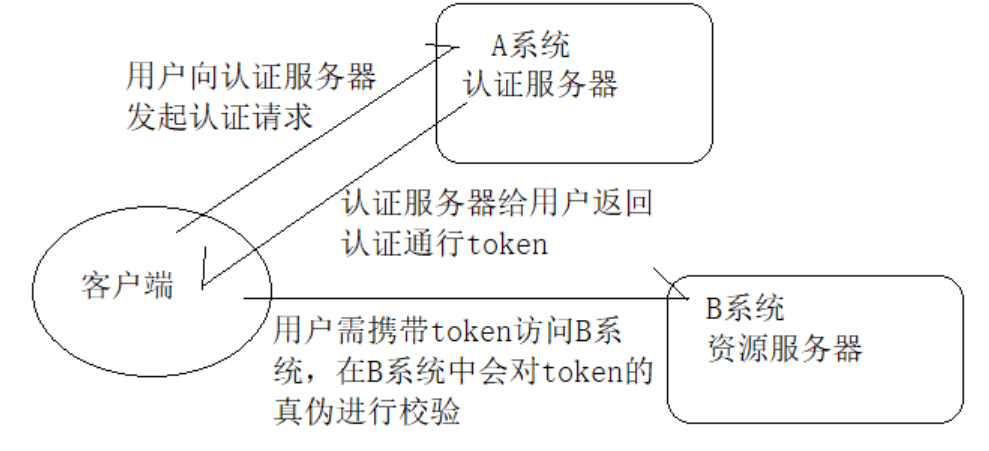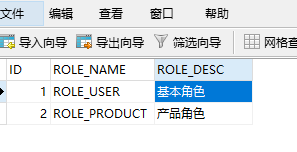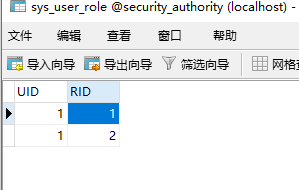分布式认证概念说明
分布式认证,即我们常说的单点登录,简称SSO,指的是在多应用系统的项目中,用户只需要登录一次,就可以访
问所有互相信任的应用系统。
分布式认证流程图
首先,我们要明确,在分布式项目中,每台服务器都有各自独立的session,而这些session之间是无法直接共享资
源的,所以,session通常不能被作为单点登录的技术方案。
最合理的单点登录方案流程如下图所示:

总结一下,单点登录的实现分两大环节:
用户认证:这一环节主要是用户向认证服务器发起认证请求,认证服务器给用户返回一个成功的令牌token,
主要在认证服务器中完成,即图中的A系统,注意A系统只能有一个。
身份校验:这一环节是用户携带token去访问其他服务器时,在其他服务器中要对token的真伪进行检验,主
要在资源服务器中完成,即图中的B系统,这里B系统可以有很多个。
JWT介绍
从分布式认证流程中,我们不难发现,这中间起最关键作用的就是token,token的安全与否,直接关系到系统的
健壮性,这里我们选择使用JWT来实现token的生成和校验。
JWT,全称JSON Web Token,官网地址https://jwt.io,是一款出色的分布式身份校验方案。可以生成token,也可
以解析检验token。
JWT生成的token由三部分组成:
头部:主要设置一些规范信息,签名部分的编码格式就在头部中声明。
载荷:token中存放有效信息的部分,比如用户名,用户角色,过期时间等,但是不要放密码,会泄露!
签名:将头部与载荷分别采用base64编码后,用“.”相连,再加入盐,最后使用头部声明的编码类型进行编码,就得到了签名。
JWT生成token的安全性分析:
从JWT生成的token组成上来看,要想避免token被伪造,主要就得看签名部分了,而签名部分又有三部分组成,其
中头部和载荷的base64编码,几乎是透明的,毫无安全性可言,那么最终守护token安全的重担就落在了加入的盐
上面了!
非对称加密RSA介绍
基本原理:同时生成两把密钥:私钥和公钥,私钥隐秘保存,公钥可以下发给信任客户端
私钥加密,持有私钥或公钥才可以解密
公钥加密,持有私钥才可解密
优点:安全,难以破解
缺点:算法比较耗时,为了安全,可以接受
历史:三位数学家Rivest、Shamir 和 Adleman 设计了一种算法,可以实现非对称加密。这种算法用他们三
个人的名字缩写:RSA。
JWT相关工具类
jar包
<dependency> <groupId>io.jsonwebtoken</groupId> <artifactId>jjwt-api</artifactId> <version>0.10.7</version> </dependency> <dependency> <groupId>io.jsonwebtoken</groupId> <artifactId>jjwt-impl</artifactId> <version>0.10.7</version> <scope>runtime</scope> </dependency> <dependency> <groupId>io.jsonwebtoken</groupId> <artifactId>jjwt-jackson</artifactId> <version>0.10.7</version> <scope>runtime</scope> </dependency>
载荷对象
@Data public class Payload<T> { private String id; private T userInfo; private Date expiration; }
public class JsonUtils { public static final ObjectMapper mapper = new ObjectMapper(); private static final Logger logger = LoggerFactory.getLogger(JsonUtils.class); public static String toString(Object obj) { if (obj == null) { return null; } if (obj.getClass() == String.class) { return (String) obj; } try { return mapper.writeValueAsString(obj); } catch (JsonProcessingException e) { logger.error("json序列化出错:" + obj, e); return null; } } public static <T> T toBean(String json, Class<T> tClass) { try { return mapper.readValue(json, tClass); } catch (IOException e) { logger.error("json解析出错:" + json, e); return null; } } public static <E> List<E> toList(String json, Class<E> eClass) { try { return mapper.readValue(json, mapper.getTypeFactory().constructCollectionType(List.class, eClass)); } catch (IOException e) { logger.error("json解析出错:" + json, e); return null; } } public static <K, V> Map<K, V> toMap(String json, Class<K> kClass, Class<V> vClass) { try { return mapper.readValue(json, mapper.getTypeFactory().constructMapType(Map.class, kClass, vClass)); } catch (IOException e) { logger.error("json解析出错:" + json, e); return null; } } public static <T> T nativeRead(String json, TypeReference<T> type) { try { return mapper.readValue(json, type); } catch (IOException e) { logger.error("json解析出错:" + json, e); return null; } } }
public class JwtUtils { private static final String JWT_PAYLOAD_USER_KEY = "user"; /** * 私钥加密token * * @param userInfo 载荷中的数据 * @param privateKey 私钥 * @param expire 过期时间,单位分钟 * @return JWT */ public static String generateTokenExpireInMinutes(Object userInfo, PrivateKey privateKey, int expire) { return Jwts.builder() .claim(JWT_PAYLOAD_USER_KEY, JsonUtils.toString(userInfo)) .setId(createJTI()) .setExpiration(DateTime.now().plusMinutes(expire).toDate()) .signWith(privateKey, SignatureAlgorithm.RS256) .compact(); } /** * 私钥加密token * * @param userInfo 载荷中的数据 * @param privateKey 私钥 * @param expire 过期时间,单位秒 * @return JWT */ public static String generateTokenExpireInSeconds(Object userInfo, PrivateKey privateKey, int expire) { return Jwts.builder() .claim(JWT_PAYLOAD_USER_KEY, JsonUtils.toString(userInfo)) .setId(createJTI()) .setExpiration(DateTime.now().plusSeconds(expire).toDate()) .signWith(privateKey, SignatureAlgorithm.RS256) .compact(); } /** * 公钥解析token * * @param token 用户请求中的token * @param publicKey 公钥 * @return Jws<Claims> */ private static Jws<Claims> parserToken(String token, PublicKey publicKey) { return Jwts.parser().setSigningKey(publicKey).parseClaimsJws(token); } private static String createJTI() { return new String(Base64.getEncoder().encode(UUID.randomUUID().toString().getBytes())); } /** * 获取token中的用户信息 * * @param token 用户请求中的令牌 * @param publicKey 公钥 * @return 用户信息 */ public static <T> Payload<T> getInfoFromToken(String token, PublicKey publicKey, Class<T> userType) { Jws<Claims> claimsJws = parserToken(token, publicKey); Claims body = claimsJws.getBody(); Payload<T> claims = new Payload<>(); claims.setId(body.getId()); claims.setUserInfo(JsonUtils.toBean(body.get(JWT_PAYLOAD_USER_KEY).toString(), userType)); claims.setExpiration(body.getExpiration()); return claims; } /** * 获取token中的载荷信息 * * @param token 用户请求中的令牌 * @param publicKey 公钥 * @return 用户信息 */ public static <T> Payload<T> getInfoFromToken(String token, PublicKey publicKey) { Jws<Claims> claimsJws = parserToken(token, publicKey); Claims body = claimsJws.getBody(); Payload<T> claims = new Payload<>(); claims.setId(body.getId()); claims.setExpiration(body.getExpiration()); return claims; } }
public class RsaUtils { private static final int DEFAULT_KEY_SIZE = 2048; /** * 从文件中读取公钥 * * @param filename 公钥保存路径,相对于classpath * @return 公钥对象 * @throws Exception */ public static PublicKey getPublicKey(String filename) throws Exception { byte[] bytes = readFile(filename); return getPublicKey(bytes); } /** * 从文件中读取密钥 * * @param filename 私钥保存路径,相对于classpath * @return 私钥对象 * @throws Exception */ public static PrivateKey getPrivateKey(String filename) throws Exception { byte[] bytes = readFile(filename); return getPrivateKey(bytes); } /** * 获取公钥 * * @param bytes 公钥的字节形式 * @return * @throws Exception */ private static PublicKey getPublicKey(byte[] bytes) throws Exception { bytes = Base64.getDecoder().decode(bytes); X509EncodedKeySpec spec = new X509EncodedKeySpec(bytes); KeyFactory factory = KeyFactory.getInstance("RSA"); return factory.generatePublic(spec); } /** * 获取密钥 * * @param bytes 私钥的字节形式 * @return * @throws Exception */ private static PrivateKey getPrivateKey(byte[] bytes) throws NoSuchAlgorithmException, InvalidKeySpecException { bytes = Base64.getDecoder().decode(bytes); PKCS8EncodedKeySpec spec = new PKCS8EncodedKeySpec(bytes); KeyFactory factory = KeyFactory.getInstance("RSA"); return factory.generatePrivate(spec); } /** * 根据密文,生存rsa公钥和私钥,并写入指定文件 * * @param publicKeyFilename 公钥文件路径 * @param privateKeyFilename 私钥文件路径 * @param secret 生成密钥的密文 */ public static void generateKey(String publicKeyFilename, String privateKeyFilename, String secret, int keySize) throws Exception { KeyPairGenerator keyPairGenerator = KeyPairGenerator.getInstance("RSA"); SecureRandom secureRandom = new SecureRandom(secret.getBytes()); keyPairGenerator.initialize(Math.max(keySize, DEFAULT_KEY_SIZE), secureRandom); KeyPair keyPair = keyPairGenerator.genKeyPair(); // 获取公钥并写出 byte[] publicKeyBytes = keyPair.getPublic().getEncoded(); publicKeyBytes = Base64.getEncoder().encode(publicKeyBytes); writeFile(publicKeyFilename, publicKeyBytes); // 获取私钥并写出 byte[] privateKeyBytes = keyPair.getPrivate().getEncoded(); privateKeyBytes = Base64.getEncoder().encode(privateKeyBytes); writeFile(privateKeyFilename, privateKeyBytes); } private static byte[] readFile(String fileName) throws Exception { return Files.readAllBytes(new File(fileName).toPath()); } private static void writeFile(String destPath, byte[] bytes) throws IOException { File dest = new File(destPath); if (!dest.exists()) { dest.createNewFile(); } Files.write(dest.toPath(), bytes); } }
回顾集中式认证流程
用户认证:
使用UsernamePasswordAuthenticationFilter过滤器中attemptAuthentication方法实现认证功能,该过滤
器父类中successfulAuthentication方法实现认证成功后的操作。
身份校验:
使用BasicAuthenticationFilter过滤器中doFilterInternal方法验证是否登录,以决定能否进入后续过滤器。
分析分布式认证流程
用户认证:
由于,分布式项目,多数是前后端分离的架构设计,我们要满足可以接受异步post的认证请求参数,需要修
改UsernamePasswordAuthenticationFilter过滤器中attemptAuthentication方法,让其能够接收请求体。
另外,默认successfulAuthentication方法在认证通过后,是把用户信息直接放入session就完事了,现在我
们需要修改这个方法,在认证通过后生成token并返回给用户。
身份校验:
原来BasicAuthenticationFilter过滤器中doFilterInternal方法校验用户是否登录,就是看session中是否有用
户信息,我们要修改为,验证用户携带的token是否合法,并解析出用户信息,交给SpringSecurity,以便于
后续的授权功能可以正常使用。
SpringSecurity+JWT+RSA分布式认证实现
public class RsaUtilsTest { private String privateFilePath = "D:\id_key_rsa"; private String publicFilePath = "D:\id_key_rsa.pub"; @Test public void generateKey() throws Exception { RsaUtils.generateKey(publicFilePath, privateFilePath, "topcheer", 2048); } @Test public void getPublicKey() throws Exception { System.out.println(RsaUtils.getPublicKey(publicFilePath)); } @Test public void getPrivateKey() throws Exception { System.out.println(RsaUtils.getPrivateKey(privateFilePath)); } @Test public void testGetPublicKey() { } @Test public void testGetPrivateKey() { } @Test public void testGenerateKey() { } }

认证服务
创建认证服务工程并导入jar包
<dependencies> <dependency> <groupId>org.springframework.boot</groupId> <artifactId>spring-boot-starter-web</artifactId> </dependency> <dependency> <groupId>org.springframework.boot</groupId> <artifactId>spring-boot-starter-security</artifactId> </dependency> <dependency> <groupId>com.topcheer</groupId> <artifactId>topcheer_common</artifactId> <version>1.0-SNAPSHOT</version> </dependency> <dependency> <groupId>mysql</groupId> <artifactId>mysql-connector-java</artifactId> <version>5.1.47</version> </dependency> <dependency> <groupId>org.mybatis.spring.boot</groupId> <artifactId>mybatis-spring-boot-starter</artifactId> <version>2.1.0</version> </dependency> </dependencies>
配置文件
server:
port: 9001
spring:
datasource:
driver-class-name: com.mysql.jdbc.Driver
url: jdbc:mysql:///security_authority
username: root
password: 123456
mybatis:
type-aliases-package: com.topcheer.domain
configuration:
map-underscore-to-camel-case: true
logging:
level:
com.topcheer: debug
rsa:
key:
pubKeyFile: D:id_key_rsa.pub
priKeyFile: D:id_key_rsa
提供解析公钥和私钥的配置类
@ConfigurationProperties("rsa.key")
public class RsaKeyProperties {
private String pubKeyFile;
private String priKeyFile;
private PublicKey publicKey;
private PrivateKey privateKey;
@PostConstruct
public void createRsaKey() throws Exception {
publicKey = RsaUtils.getPublicKey(pubKeyFile);
privateKey = RsaUtils.getPrivateKey(priKeyFile);
}
public String getPubKeyFile() {
return pubKeyFile;
}
public void setPubKeyFile(String pubKeyFile) {
this.pubKeyFile = pubKeyFile;
}
public String getPriKeyFile() {
return priKeyFile;
}
public void setPriKeyFile(String priKeyFile) {
this.priKeyFile = priKeyFile;
}
public PublicKey getPublicKey() {
return publicKey;
}
public void setPublicKey(PublicKey publicKey) {
this.publicKey = publicKey;
}
public PrivateKey getPrivateKey() {
return privateKey;
}
public void setPrivateKey(PrivateKey privateKey) {
this.privateKey = privateKey;
}
}
配置类
@SpringBootApplication @MapperScan("com.topcheer.mapper") @EnableConfigurationProperties(RsaKeyProperties.class) public class AuthServerApplication { public static void main(String[] args) { SpringApplication.run(AuthServerApplication.class, args); } }
认证过滤器:
public class JwtLoginFilter extends UsernamePasswordAuthenticationFilter { private AuthenticationManager authenticationManager; private RsaKeyProperties prop; public JwtLoginFilter(AuthenticationManager authenticationManager, RsaKeyProperties prop) { this.authenticationManager = authenticationManager; this.prop = prop; } @Override public Authentication attemptAuthentication(HttpServletRequest request, HttpServletResponse response) throws AuthenticationException { try { SysUser sysUser = new ObjectMapper().readValue(request.getInputStream(), SysUser.class); UsernamePasswordAuthenticationToken authRequest = new UsernamePasswordAuthenticationToken(sysUser.getUsername(), sysUser.getPassword()); return authenticationManager.authenticate(authRequest); }catch (Exception e){ try { response.setContentType("application/json;charset=utf-8"); response.setStatus(HttpServletResponse.SC_UNAUTHORIZED); PrintWriter out = response.getWriter(); Map resultMap = new HashMap(); resultMap.put("code", HttpServletResponse.SC_UNAUTHORIZED); resultMap.put("msg", "用户名或密码错误!"); out.write(new ObjectMapper().writeValueAsString(resultMap)); out.flush(); out.close(); }catch (Exception outEx){ outEx.printStackTrace(); } throw new RuntimeException(e); } } @Override public void successfulAuthentication(HttpServletRequest request, HttpServletResponse response, FilterChain chain, Authentication authResult) throws IOException, ServletException { SysUser user = new SysUser(); user.setUsername(authResult.getName()); user.setRoles((List<SysRole>) authResult.getAuthorities()); String token = JwtUtils.generateTokenExpireInMinutes(user, prop.getPrivateKey(), 24 * 60); response.addHeader("Authorization", "Bearer "+token); try { response.setContentType("application/json;charset=utf-8"); response.setStatus(HttpServletResponse.SC_OK); PrintWriter out = response.getWriter(); Map resultMap = new HashMap(); resultMap.put("code", HttpServletResponse.SC_OK); resultMap.put("msg", "认证通过!"); out.write(new ObjectMapper().writeValueAsString(resultMap)); out.flush(); out.close(); }catch (Exception outEx){ outEx.printStackTrace(); } } }
@Configuration @EnableWebSecurity @EnableGlobalMethodSecurity(securedEnabled=true) public class WebSecurityConfig extends WebSecurityConfigurerAdapter { @Autowired private UserService userService; @Autowired private RsaKeyProperties prop; @Bean public BCryptPasswordEncoder passwordEncoder(){ return new BCryptPasswordEncoder(); } //指定认证对象的来源 @Override public void configure(AuthenticationManagerBuilder auth) throws Exception { auth.userDetailsService(userService).passwordEncoder(passwordEncoder()); } //SpringSecurity配置信息 @Override public void configure(HttpSecurity http) throws Exception { http.csrf() .disable() .authorizeRequests() .antMatchers("/product").hasAnyRole("USER") .anyRequest() .authenticated() .and() .addFilter(new JwtLoginFilter(super.authenticationManager(), prop)) .sessionManagement().sessionCreationPolicy(SessionCreationPolicy.STATELESS); } }
启动测试认证服务
认证请求


资源服务
资源服务可以有很多个,这里只拿产品服务为例,记住,资源服务中只能通过公钥验证认证。不能签发token!
创建产品服务并导入jar包
根据实际业务导包即可,咱们就暂时和认证服务一样了。
<dependencies> <dependency> <groupId>org.springframework.boot</groupId> <artifactId>spring-boot-starter-web</artifactId> </dependency> <dependency> <groupId>org.springframework.boot</groupId> <artifactId>spring-boot-starter-security</artifactId> </dependency> <dependency> <groupId>com.topcheer</groupId> <artifactId>topcheer_common</artifactId> <version>1.0-SNAPSHOT</version> </dependency> <dependency> <groupId>mysql</groupId> <artifactId>mysql-connector-java</artifactId> <version>5.1.47</version> </dependency> <dependency> <groupId>org.mybatis.spring.boot</groupId> <artifactId>mybatis-spring-boot-starter</artifactId> <version>2.1.0</version> </dependency> </dependencies>
编写产品服务配置文件
切记这里只能有公钥地址!
server:
port: 9002
spring:
datasource:
driver-class-name: com.mysql.jdbc.Driver
url: jdbc:mysql:///security_authority
username: root
password: 123456
mybatis:
type-aliases-package: com.topcheer.domain
configuration:
map-underscore-to-camel-case: true
logging:
level:
com.topcheer: debug
rsa:
key:
pubKeyFile: D:id_key_rsa.pub
编写读取公钥的配置类
@ConfigurationProperties("rsa.key")
public class RsaKeyProperties {
private String pubKeyFile;
private PublicKey publicKey;
@PostConstruct
public void createRsaKey() throws Exception {
publicKey = RsaUtils.getPublicKey(pubKeyFile);
}
public String getPubKeyFile() {
return pubKeyFile;
}
public void setPubKeyFile(String pubKeyFile) {
this.pubKeyFile = pubKeyFile;
}
public PublicKey getPublicKey() {
return publicKey;
}
public void setPublicKey(PublicKey publicKey) {
this.publicKey = publicKey;
}
}
@Configuration @EnableWebSecurity @EnableGlobalMethodSecurity(securedEnabled=true) public class WebSecurityConfig extends WebSecurityConfigurerAdapter { @Autowired private RsaKeyProperties prop; //SpringSecurity配置信息 @Override public void configure(HttpSecurity http) throws Exception { http.csrf() .disable() .authorizeRequests() .antMatchers("/product").hasAnyRole("USER") .anyRequest() .authenticated() .and() .addFilter(new JwtVerifyFilter(super.authenticationManager(), prop)) .sessionManagement().sessionCreationPolicy(SessionCreationPolicy.STATELESS); } }
web层
@RestController @RequestMapping("/product") public class ProductController { @Secured("ROLE_PRODUCT") @RequestMapping("/findAll") public String findAll(){ return "产品列表查询成功!"; } }
验证token服务器
public class JwtVerifyFilter extends BasicAuthenticationFilter { private RsaKeyProperties prop; public JwtVerifyFilter(AuthenticationManager authenticationManager, RsaKeyProperties prop) { super(authenticationManager); this.prop = prop; } @Override public void doFilterInternal(HttpServletRequest request, HttpServletResponse response, FilterChain chain) throws IOException, ServletException { String header = request.getHeader("Authorization"); if (header == null || !header.startsWith("Bearer ")) { //如果携带错误的token,则给用户提示请登录! chain.doFilter(request, response); response.setContentType("application/json;charset=utf-8"); response.setStatus(HttpServletResponse.SC_FORBIDDEN); PrintWriter out = response.getWriter(); Map resultMap = new HashMap(); resultMap.put("code", HttpServletResponse.SC_FORBIDDEN); resultMap.put("msg", "请登录!"); out.write(new ObjectMapper().writeValueAsString(resultMap)); out.flush(); out.close(); } else { //如果携带了正确格式的token要先得到token String token = header.replace("Bearer ", ""); //验证tken是否正确 Payload<SysUser> payload = JwtUtils.getInfoFromToken(token, prop.getPublicKey(), SysUser.class); SysUser user = payload.getUserInfo(); if(user!=null){ UsernamePasswordAuthenticationToken authResult = new UsernamePasswordAuthenticationToken(user.getUsername(), null, user.getAuthorities()); SecurityContextHolder.getContext().setAuthentication(authResult); chain.doFilter(request, response); } } } }
测试:
携带上面的token进行访问这个服务器

当这个用户没有权限的时候,就报这个错,下面给用户添加权限


